2016 MITSUBISHI OUTLANDER SPORT warning
[x] Cancel search: warningPage 50 of 398
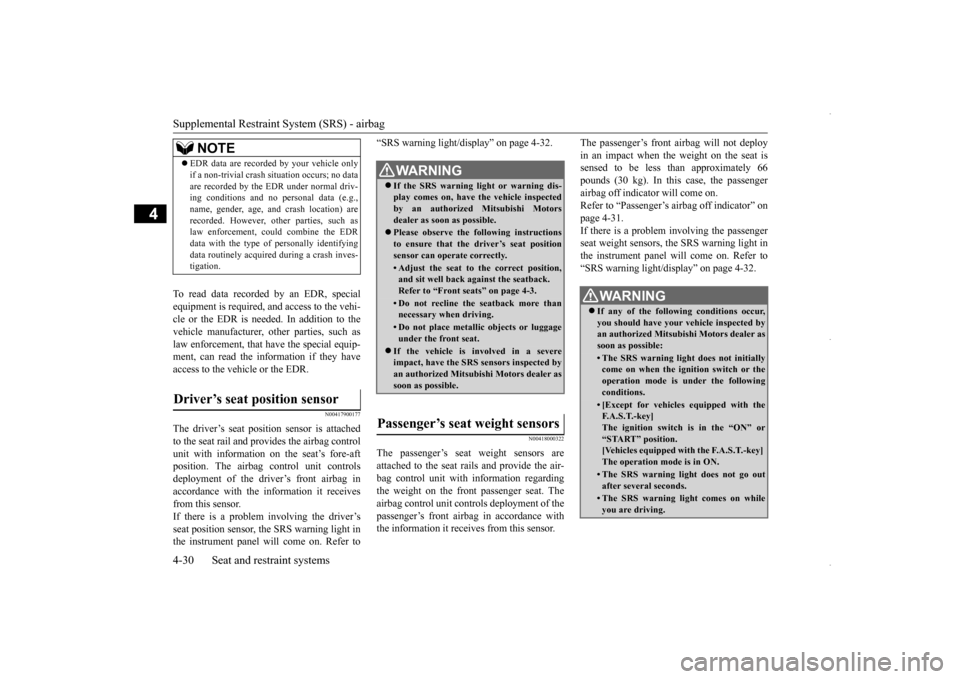
Supplemental Restraint System (SRS) - airbag 4-30 Seat and restraint systems
4
To read data recorded by an EDR, special equipment is required, and access to the vehi- cle or the EDR is needed. In addition to the vehicle manufacturer, other parties, such aslaw enforcement, that have the special equip- ment, can read the information if they have access to the vehicle or the EDR.
N00417900177
The driver’s seat position sensor is attachedto the seat rail and provides the airbag controlunit with information on the seat’s fore-aft position. The airbag control unit controls deployment of the driver’s front airbag inaccordance with the information it receives from this sensor. If there is a problem involving the driver’sseat position sensor, the SRS warning light in the instrument panel will come on. Refer to
“SRS warning light/display” on page 4-32.
N00418000322
The passenger’s seat weight sensors are attached to the seat rails and provide the air- bag control unit with information regarding the weight on the front passenger seat. Theairbag control unit controls deployment of the passenger’s front airbag in accordance with the information it receives from this sensor.
The passenger’s front airbag will not deploy in an impact when the weight on the seat is sensed to be less than approximately 66 pounds (30 kg). In this case, the passengerairbag off indicator will come on. Refer to “Passenger’s airbag off indicator” on page 4-31.If there is a problem involving the passenger seat weight sensors, the SRS warning light in the instrument panel will come on. Refer to“SRS warning light/display” on page 4-32.
NOTE
EDR data are recorded by your vehicle only if a non-trivial crash situation occurs; no data are recorded by the EDR under normal driv- ing conditions and no personal data (e.g., name, gender, age, and crash location) arerecorded. However, other parties, such as law enforcement, could combine the EDR data with the type of personally identifyingdata routinely acquired during a crash inves- tigation.
Driver’s seat position sensor
WA R N I N G If the SRS warning light or warning dis- play comes on, have the vehicle inspectedby an authorized Mitsubishi Motors dealer as soon as possible. Please observe the following instructions to ensure that the driver’s seat position sensor can operate correctly.• Adjust the seat to the correct position,and sit well back against the seatback.Refer to “Front seats” on page 4-3.• Do not recline the seatback more thannecessary when driving.• Do not place metallic objects or luggageunder the front seat.
If the vehicle is involved in a severe impact, have the SRS sensors inspected by an authorized Mitsubishi Motors dealer as soon as possible.
Passenger’s seat weight sensors
WA R N I N G If any of the following conditions occur, you should have your vehicle inspected by an authorized Mitsubishi Motors dealer assoon as possible:• The SRS warning light does not initiallycome on when the ignition switch or the operation mode is under the following conditions.• [Except for vehicles equipped with theF. A . S . T. - k e y ]The ignition switch is in the “ON” or “START” position. [Vehicles equipped with the F.A.S.T.-key] The operation mode is in ON.• The SRS warning light does not go outafter several seconds.• The SRS warning light comes on whileyou are driving.
BK0229600US.bo
ok 30 ページ 2015年10月1日 木曜日 午後2時29分
Page 52 of 398
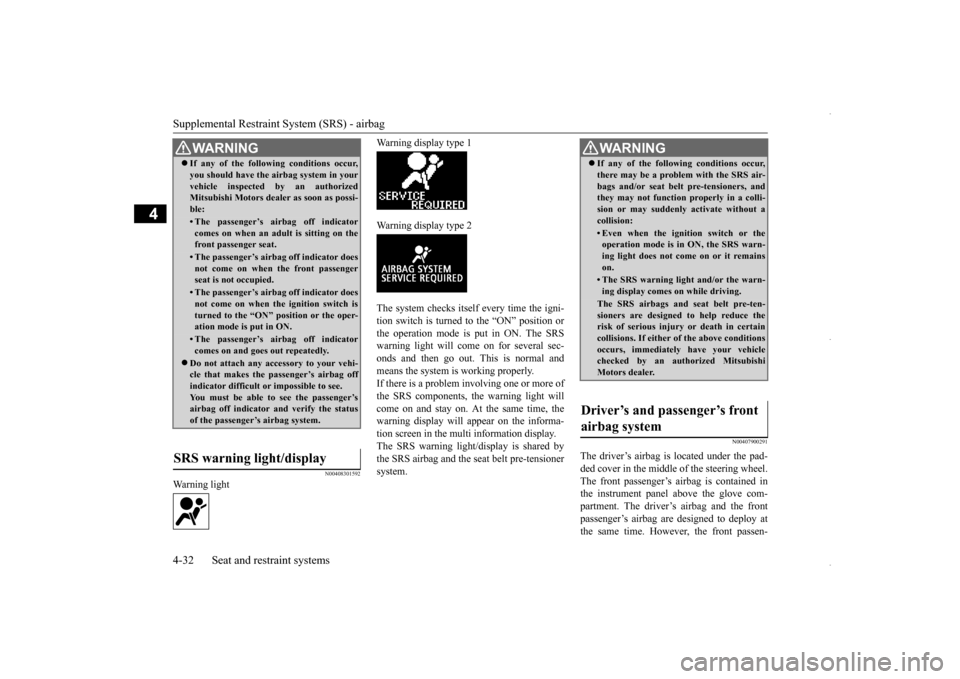
Supplemental Restraint System (SRS) - airbag 4-32 Seat and restraint systems
4
N00408301592
Warning light
Warning display type 1 Warning display type 2The system checks itself every time the igni- tion switch is turned to the “ON” position orthe operation mode is put in ON. The SRS warning light will come on for several sec- onds and then go out. This is normal andmeans the system is working properly. If there is a problem involving one or more of the SRS components, the warning light willcome on and stay on. At the same time, the warning display will appear on the informa- tion screen in the multi information display.The SRS warning light/display is shared bythe SRS airbag and the seat belt pre-tensioner system.
N00407900291
The driver’s airbag is located under the pad- ded cover in the middle of the steering wheel.The front passenger’s airbag is contained in the instrument panel above the glove com- partment. The driver’s airbag and the frontpassenger’s airbag are designed to deploy at the same time. However,
the front passen-
WA R N I N GIf any of the following conditions occur, you should have the airbag system in your vehicle inspected by an authorized Mitsubishi Motors dealer as soon as possi- ble:• The passenger’s airbag off indicatorcomes on when an adult is sitting on thefront passenger seat.• The passenger’s airbag off indicator doesnot come on when the front passenger seat is not occupied.• The passenger’s airbag off indicator doesnot come on when the ignition switch is turned to the “ON” position or the oper-ation mode is put in ON.• The passenger’s airbag off indicatorcomes on and goes out repeatedly.
Do not attach any accessory to your vehi- cle that makes the passenger’s airbag off indicator difficult or impossible to see. You must be able to see the passenger’sairbag off indicator and verify the status of the passenger’s airbag system.
SRS warning light/display
WA R N I N G If any of the following conditions occur, there may be a problem with the SRS air- bags and/or seat belt pre-tensioners, and they may not function properly in a colli- sion or may suddenly activate without acollision:• Even when the ignition switch or theoperation mode is in ON, the SRS warn- ing light does not come on or it remains on.• The SRS warning light and/or the warn-ing display comes on while driving.The SRS airbags and seat belt pre-ten-sioners are designed to help reduce therisk of serious injury or death in certain collisions. If either of the above conditions occurs, immediately have your vehiclechecked by an authorized Mitsubishi Motors dealer.
Driver’s and passenger’s front airbag system
BK0229600US.bo
ok 32 ページ 2015年10月1日 木曜日 午後2時29分
Page 62 of 398
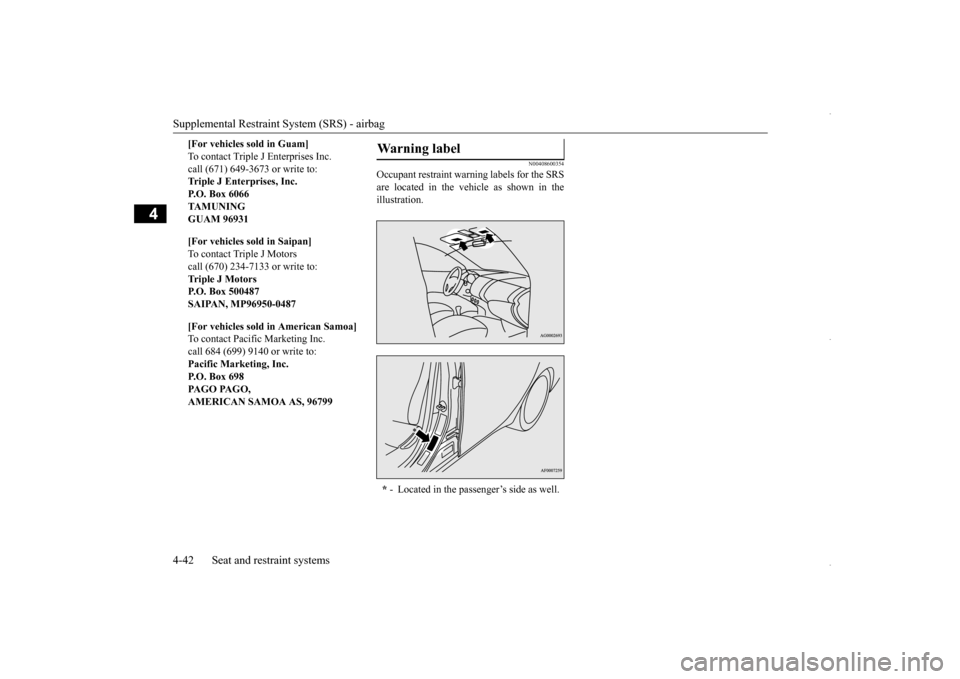
Supplemental Restraint System (SRS) - airbag 4-42 Seat and restraint systems
4
N00408600354
Occupant restraint warning labels for the SRS are located in the vehicle as shown in theillustration.
[For vehicles sold in Guam] To contact Triple J Enterprises Inc.call (671) 649-3673 or write to: Triple J Enterprises, Inc. P.O. Box 6066TA M U N I N G GUAM 96931 [For vehicles sold in Saipan] To contact Triple J Motorscall (670) 234-7133 or write to:Triple J Motors P.O. Box 500487 SAIPAN, MP96950-0487 [For vehicles sold in American Samoa] To contact Pacific Marketing Inc. call 684 (699) 9140 or write to: Pacific Marketing, Inc.P.O. Box 698 PAGO PAGO, AMERICAN SAMOA AS, 96799
Warning label * - Located in the passenger’s side as well.
BK0229600US.bo
ok 42 ページ 2015年10月1日 木曜日 午後2時29分
Page 63 of 398
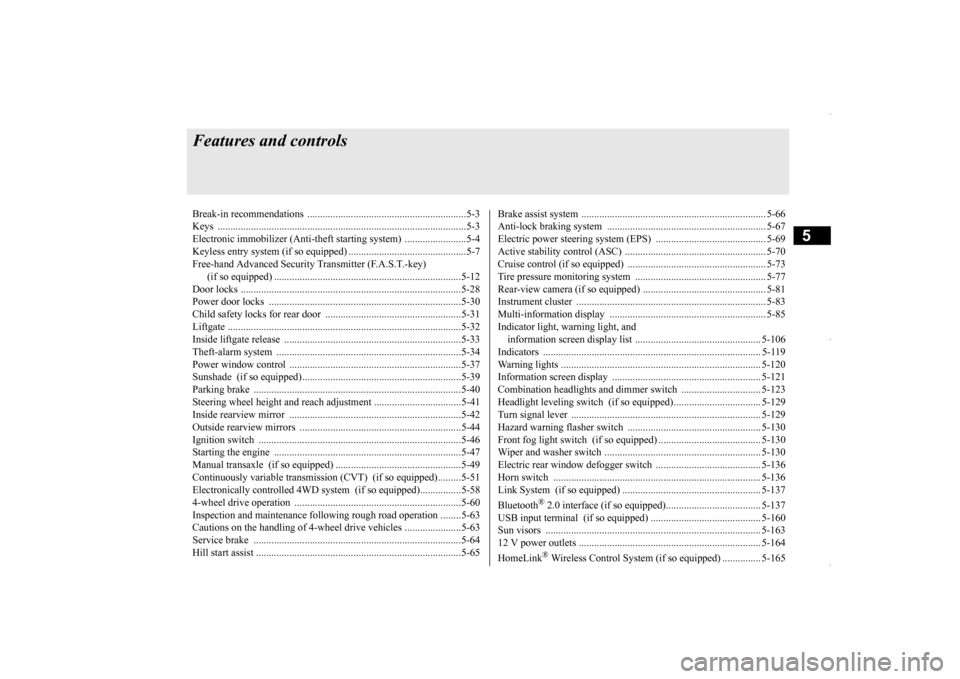
5
Features and controlsBreak-in recommendation
s ..............................................................5-3
Keys ..........................................
.......................................................5-3
Electronic immobilizer (Anti-thef
t starting system) ........................5-4
Keyless entry system (if so equipped) ..............................................5-7Free-hand Advanced Security Transmitter (F.A.S.T.-key) (if so equipped)
.................................................
........................5-12
Door locks .......................
...............................................................5-28
Power door locks ............
...............................................................5-30
Child safety locks for r
ear door .....................................................5-31
Liftgate ......................................
.....................................................5-32
Inside liftgate releas
e .............................................
........................5-33
Theft-alarm system
................................................
........................5-34
Power window control
...........................................
........................5-37
Sunshade (if so equi
pped)..............................................................5-39
Parking brake ..................
...............................................................5-40
Steering wheel height and reach adjustment ..................................5-41Inside rearview mirro
r ...........................................
........................5-42
Outside rearview mirr
ors ...............................................................5-44
Ignition switch ......
.................................................
........................5-46
Starting the engine
.................................................
........................5-47
Manual transaxle (if so equipped) .................................................5-49 Continuously variable transmission
(CVT) (if so equipped).........5-51
Electronically controlled 4WD system (if so equipped)................5-584-wheel drive operation
.........................................
........................5-60
Inspection and maintenance following rough road operation ........5-63 Cautions on the handling of 4-wheel drive vehicles ......................5-63Service brake ..................
...............................................................5-64
Hill start assist .......
.................................................
........................5-65
Brake assist system
...............................................
......................... 5-66
Anti-lock braking syst
em .....................................
......................... 5-67
Electric power steering syst
em (EPS) ........................................... 5-69
Active stability control
(ASC) ....................
................................... 5-70
Cruise control (if so eq
uipped) ...................................................... 5-73
Tire pressure monitoring
system ................................................... 5-77
Rear-view camera (if so eq
uipped) ................................................ 5-81
Instrument cluster
.................................................
......................... 5-83
Multi-information disp
lay ....................................
......................... 5-85
Indicator light, warning light, and information screen disp
lay list ................................................. 5-106
Indicators .................................
.................................................... 5-119
Warning lights ................
.................................................
............. 5-120
Information screen disp
lay ...................................
....................... 5-121
Combination headlights and dimmer switch ............................... 5-123 Headlight leveling switch (if so equipped).................................. 5-129Turn signal lever ..
.................................................
....................... 5-129
Hazard warning flasher
switch .................................................... 5-130
Front fog light switch (if
so equipped) ........................................ 5-130
Wiper and washer swit
ch ......................................
....................... 5-130
Electric rear window def
ogger switch ......................................... 5-136
Horn switch .............................
.................................................... 5-136
Link System (if so equi
pped) .....................
................................. 5-137
Bluetooth
® 2.0 interface (if so
equipped)..................................... 5-137
USB input terminal (if so
equipped) ........................................... 5-160
Sun visors ......................
.................................................
............. 5-163
12 V power outlets .........
.................................................
............. 5-164
HomeLink
® Wireless Control System (if so equipped) ............... 5-165
BK0229600US.bo
ok 1 ページ 2015年10月1日 木曜日 午後2時29分
Page 80 of 398
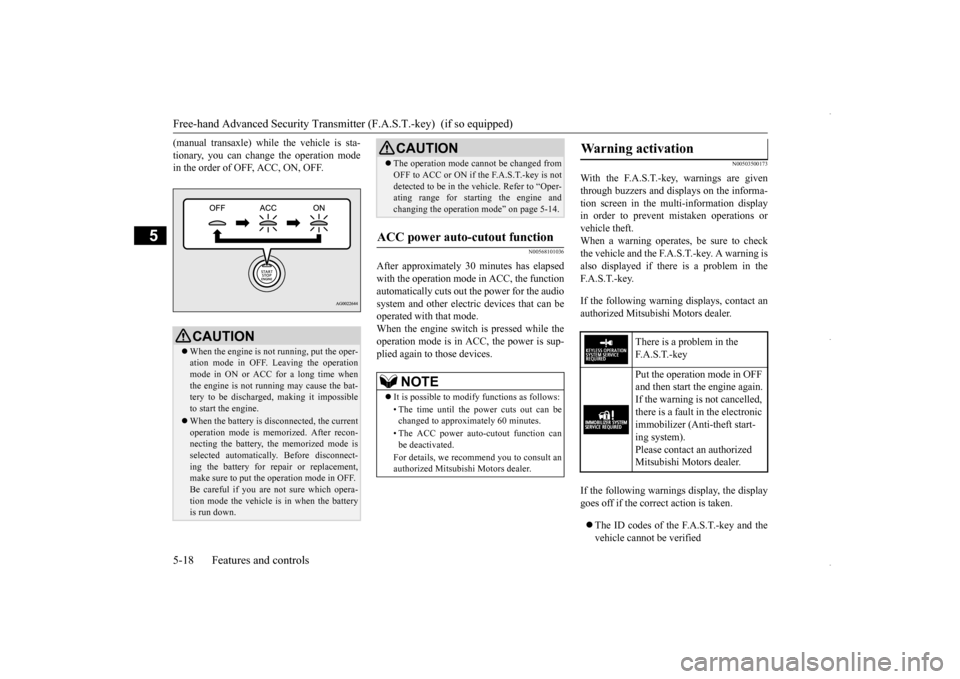
Free-hand Advanced Security Transmitte
r (F.A.S.T.-key) (if so equipped)
5-18 Features and controls
5
(manual transaxle) while the vehicle is sta- tionary, you can change the operation mode in the order of OFF, ACC, ON, OFF.
N00568101036
After approximately 30 minutes has elapsed with the operation mode in ACC, the functionautomatically cuts out
the power for the audio
system and other electric devices that can be operated with that mode.When the engine switch is pressed while the operation mode is in ACC, the power is sup- plied again to those devices.
N00503500173
With the F.A.S.T.-key, warnings are giventhrough buzzers and displays on the informa-tion screen in the multi-information display in order to prevent mistaken operations or vehicle theft.When a warning operates, be sure to check the vehicle and the F.A.S.T.-key. A warning is also displayed if there is a problem in theF. A . S . T. - k e y. If the following warning displays, contact an authorized Mitsubishi Motors dealer. If the following warnings display, the display goes off if the correct action is taken. The ID codes of the F.A.S.T.-key and the vehicle cannot be verified
CAUTION When the engine is not running, put the oper- ation mode in OFF. Leaving the operationmode in ON or ACC for a long time when the engine is not running may cause the bat- tery to be discharged, making it impossibleto start the engine. When the battery is disconnected, the current operation mode is memorized. After recon- necting the battery, the memorized mode is selected automatically. Before disconnect-ing the battery for repair or replacement, make sure to put the operation mode in OFF. Be careful if you are not sure which opera-tion mode the vehicle is in when the battery is run down.
The operation mode cannot be changed from OFF to ACC or ON if th
e F.A.S.T.-key is not
detected to be in the vehicle. Refer to “Oper- ating range for starting the engine and changing the operation mode” on page 5-14.
ACC power auto-cutout function
NOTE
It is possible to modify functions as follows: • The time until the power cuts out can be changed to approximately 60 minutes. • The ACC power auto-cutout function can be deactivated. For details, we recommend you to consult an authorized Mitsubishi Motors dealer.CAUTION
Warning activation
There is a problem in the F. A . S . T. - k e y Put the operation mode in OFF and then start the engine again. If the warning is not cancelled, there is a fault in the electronic immobilizer (Anti-theft start- ing system).Please contact an authorized Mitsubishi Motors dealer.
BK0229600US.bo
ok 18 ページ 2015年10月1日 木曜日 午後2時29分
Page 81 of 398
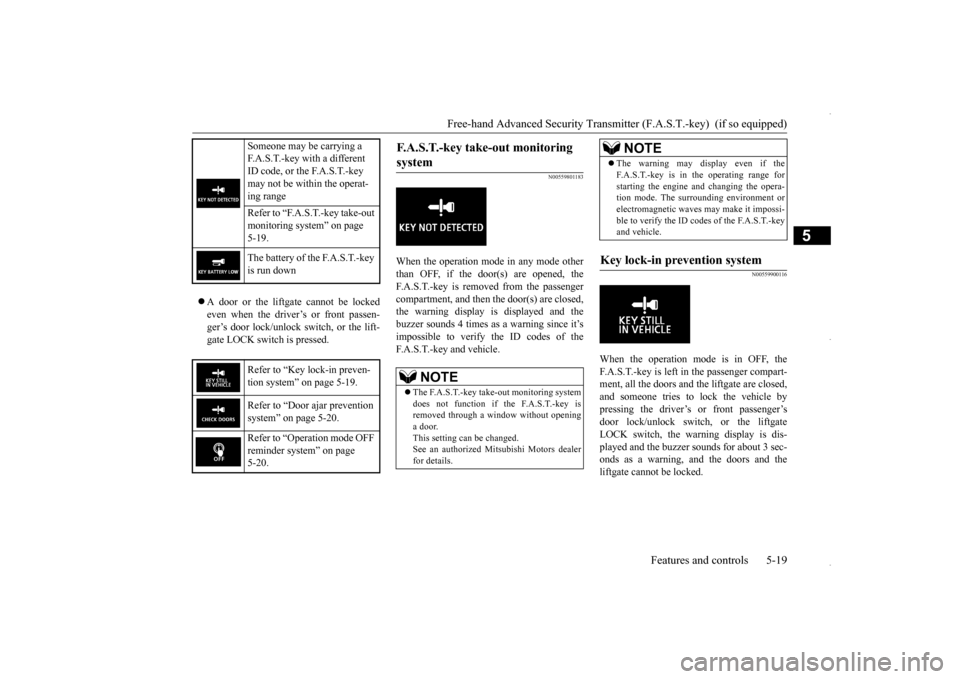
Free-hand Advanced Security Transmitt
er (F.A.S.T.-key) (if so equipped)
Features and controls 5-19
5
A door or the liftgate cannot be locked even when the driver’s or front passen- ger’s door lock/unlock switch, or the lift- gate LOCK switch is pressed.
N00559801183
When the operation mode in any mode other than OFF, if the door(s) are opened, the F.A.S.T.-key is removed from the passengercompartment, and then th
e door(s) are closed,
the warning display is displayed and the buzzer sounds 4 times as a warning since it’simpossible to verify the ID codes of the F.A.S.T.-key and vehicle.
N00559900116
When the operation mode is in OFF, theF.A.S.T.-key is left in the passenger compart- ment, all the doors and th
e liftgate are closed,
and someone tries to lock the vehicle by pressing the driver’s or front passenger’s door lock/unlock switch, or the liftgateLOCK switch, the warning display is dis- played and the buzzer
sounds for about 3 sec-
onds as a warning, and the doors and theliftgate cannot be locked.
Someone may be carrying a F.A.S.T.-key with a different ID code, or the F.A.S.T.-key may not be within the operat- ing range Refer to “F.A.S.T.-key take-out monitoring system” on page 5-19. The battery of the F.A.S.T.-key is run down Refer to “Key lock-in preven- tion system” on page 5-19. Refer to “Door ajar prevention system” on page 5-20. Refer to “Operation mode OFF reminder system” on page 5-20.
F.A.S.T.-key take-out monitoring system
NOTE
The F.A.S.T.-key take-out monitoring system does not function if the F.A.S.T.-key is removed through a window without opening a door.This setting can be changed. See an authorized Mitsubishi Motors dealer for details.
The warning may display even if the F.A.S.T.-key is in the operating range for starting the engine and changing the opera- tion mode. The surrounding environment or electromagnetic waves may make it impossi-ble to verify the ID codes of the F.A.S.T.-key and vehicle.
Key lock-in prevention system
NOTE
BK0229600US.bo
ok 19 ページ 2015年10月1日 木曜日 午後2時29分
Page 82 of 398
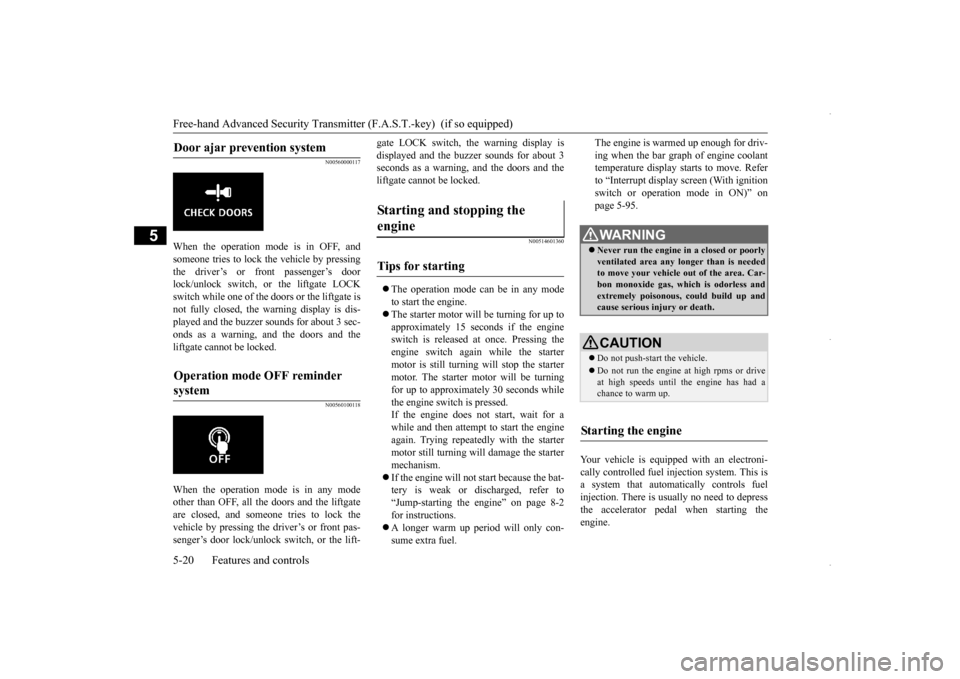
Free-hand Advanced Security Transmitte
r (F.A.S.T.-key) (if so equipped)
5-20 Features and controls
5
N00560000117
When the operation mode is in OFF, and someone tries to lock the vehicle by pressingthe driver’s or front passenger’s door lock/unlock switch, or the liftgate LOCK switch while one of the doors or the liftgate isnot fully closed, the warning display is dis- played and the buzzer
sounds for about 3 sec-
onds as a warning, and the doors and theliftgate cannot be locked.
N00560100118
When the operation mode is in any modeother than OFF, all the doors and the liftgateare closed, and someone tries to lock the vehicle by pressing the driver’s or front pas- senger’s door lock/unlock switch, or the lift-
gate LOCK switch, the warning display is displayed and the buzzer sounds for about 3 seconds as a warning, and the doors and the liftgate cannot be locked.
N00514601360
The operation mode can be in any mode to start the engine. The starter motor will be turning for up to approximately 15 seconds if the engine switch is released at once. Pressing the engine switch again while the startermotor is still turning will stop the starter motor. The starter motor will be turning for up to approximately 30 seconds whilethe engine switch is pressed. If the engine does not start, wait for a while and then attempt to start the engineagain. Trying repeatedly with the starter motor still turning will damage the starter mechanism. If the engine will not start because the bat- tery is weak or discharged, refer to “Jump-starting the engine” on page 8-2for instructions. A longer warm up period will only con- sume extra fuel.
The engine is warmed up enough for driv- ing when the bar graph of engine coolant temperature display starts to move. Refer to “Interrupt display screen (With ignitionswitch or operation mode in ON)” on page 5-95.
Your vehicle is equipped with an electroni- cally controlled fuel injection system. This isa system that automatically controls fuel injection. There is usually no need to depress the accelerator pedal when starting theengine.
Door ajar prevention system
Operation mode OFF reminder system
Starting and stopping the engine
Tips for starting
WA R N I N G Never run the engine in a closed or poorly ventilated area any longer than is needed to move your vehicle out of the area. Car- bon monoxide gas, which is odorless andextremely poisonous, could build up and cause serious injury or death.CAUTION Do not push-start the vehicle.Do not run the engine
at high rpms or drive
at high speeds until the engine has had achance to warm up.
Starting the engine
BK0229600US.bo
ok 20 ページ 2015年10月1日 木曜日 午後2時29分
Page 83 of 398

Free-hand Advanced Security Transmitt
er (F.A.S.T.-key) (if so equipped)
Features and controls 5-21
5
To prevent battery drain, wait a few seconds between attempts to restart the engine. 1. Make sure all occupants are properly seated with seat belts fastened. 2. Make sure the parking brake is applied.3. Press and hold the brake pedal down firmly with your right foot. 4. Press and hold the clutch pedal all the way down (manual transaxle). 5. On vehicles equipped with manual trans- axle, place the gearshift lever in the “N”(Neutral) position. On vehicles equipped with continuously variable transmission (CVT), make surethe selector lever is in the “P” (PARK) position.
6. Press the engine switch. 7. Confirm that all warning lights and warn- ing displays are functioning properly.
After several attempts, you may experience that the engine still does not start. 1. Make sure that all electric devices, such as lights, air conditioning blower and rear window defogger, are turned off.
2. While depressing the brake pedal {contin- uously variable transmission (CVT)} or the clutch pedal (manual transaxle), press the accelerator pedal halfway and hold itthere, then crank the engine. Release the accelerator pedal, immediately after the engine starts.3. If the engine still will not start, the engine could be flooded with too much gasoline. While depressing the brake pedal (CVT)or the clutch pedal (manual transaxle),push the accelerator pedal all the way down and hold it there, then press the engine switch to crank the engine. If theengine does not start after 5 to 6 seconds, push the engine switch to stop cranking the engine, and release the acceleratorpedal. Put the operation mode in OFF. Wait a few seconds, and then press the engine switch to crank the engine againwhile depressing the brake pedal (CVT) or the clutch pedal (manual transaxle), but do not push the accelerator pedal. If theengine fails to start, repeat these proce- dures. If the engine still will not start, con- tact your local Mitsubishi Motors dealeror a repair facility of your choice for assistance.
Startability of continuously variable trans- mission (CVT) vehicles with an ambienttemperature of
-22 °F (-30 °C) or lower
NOTE
After the engine has not started for a while, the brake pedal effort needed to start the engine may become greater. If this occurs,depress the brake pedal more firmly than usual.
NOTE
On vehicles equipped with continuously variable transmission (CVT), the engine can only be started when the selector lever is in the “P” (PARK) or “N” (NEUTRAL) posi- tion.For safety reasons, the engine should be started when the selector lever is in the “P” (PARK) position in which the driving wheelslock.NOTE
Minor noises may be heard on engine start- up. These will disappear as the engine warmsup.
When the engine is hard to start
BK0229600US.bo
ok 21 ページ 2015年10月1日 木曜日 午後2時29分